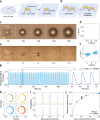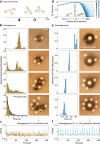Emergent microrobotic oscillators via asymmetry-induced order
- PMID: 36229440
- PMCID: PMC9561614
- DOI: 10.1038/s41467-022-33396-5
Emergent microrobotic oscillators via asymmetry-induced order
Abstract
Spontaneous oscillations on the order of several hertz are the drivers of many crucial processes in nature. From bacterial swimming to mammal gaits, converting static energy inputs into slowly oscillating power is key to the autonomy of organisms across scales. However, the fabrication of slow micrometre-scale oscillators remains a major roadblock towards fully-autonomous microrobots. Here, we study a low-frequency oscillator that emerges from a collective of active microparticles at the air-liquid interface of a hydrogen peroxide drop. Their interactions transduce ambient chemical energy into periodic mechanical motion and on-board electrical currents. Surprisingly, these oscillations persist at larger ensemble sizes only when a particle with modified reactivity is added to intentionally break permutation symmetry. We explain such emergent order through the discovery of a thermodynamic mechanism for asymmetry-induced order. The on-board power harvested from the stabilised oscillations enables the use of electronic components, which we demonstrate by cyclically and synchronously driving a microrobotic arm. This work highlights a new strategy for achieving low-frequency oscillations at the microscale, paving the way for future microrobotic autonomy.
© 2022. The Author(s).
Conflict of interest statement
The authors declare no competing interests.
Figures




References
-
- Buzsáki, G. & Draguhn, A. Neuronal oscillations in cortical networks. Science304, 1926–1929 (2004). - PubMed
-
- Kruse, K. & Jülicher, F. Oscillations in cell biology. Curr. Opin. Cell Biol.17, 20–26 (2005). - PubMed
-
- Hoyt, D. F. & Taylor, C. R. Gait and the energetics of locomotion in horses. Nature292, 239–240 (1981).
Publication types
MeSH terms
Substances
LinkOut - more resources
Full Text Sources

